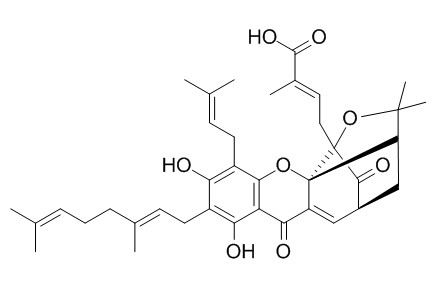Isogambogenic acid
Isogambogenic acid inhibits angiogenesis and may be a viable drug candidate in anti-angiogenesis therapy. Isogambogenic acid exhibits an anticancer effect by inducing autophagy-dependent cell death in NSCLC cells, which may be an effective chemotherapeutic agent that can be used against NSCLC in a clinical setting.
Inquire / Order:
manager@chemfaces.com
Technical Inquiries:
service@chemfaces.com
Tel:
+86-27-84237783
Fax:
+86-27-84254680
Address:
1 Building, No. 83, CheCheng Rd., Wuhan Economic and Technological Development Zone, Wuhan, Hubei 430056, PRC
Providing storage is as stated on the product vial and the vial is kept tightly sealed, the product can be stored for up to
24 months(2-8C).
Wherever possible, you should prepare and use solutions on the same day. However, if you need to make up stock solutions in advance, we recommend that you store the solution as aliquots in tightly sealed vials at -20C. Generally, these will be useable for up to two weeks. Before use, and prior to opening the vial we recommend that you allow your product to equilibrate to room temperature for at least 1 hour.
Need more advice on solubility, usage and handling? Please email to: service@chemfaces.com
The packaging of the product may have turned upside down during transportation, resulting in the natural compounds adhering to the neck or cap of the vial. take the vial out of its packaging and gently shake to let the compounds fall to the bottom of the vial. for liquid products, centrifuge at 200-500 RPM to gather the liquid at the bottom of the vial. try to avoid loss or contamination during handling.
APMIS.2019, 127(10):688-695
Nat Commun.2019, 10(1):2745
Nat Prod Commun.2014, 9(5):679-82
Molecules.2023, 28(16):6025.
Food Sci Biotechnol.2024, 33(15):3629-3637.
Journal of Food Engineering2024, 379:112136.
Drug Des Devel Ther.2020, 14:969-976.
J.Korean Society of Grassland&Forage Science2023, 43(3):138-147.
Hum Exp Toxicol.2017, 36(11):1169-1176
Genes (Basel).2021, 12(7):1024.
Related and Featured Products
Sci Rep. 2015 Jan 9;5:7697.
Isogambogenic acid induces apoptosis-independent autophagic cell death in human non-small-cell lung carcinoma cells.[Pubmed:
25571970]
To overcome drug resistance caused by apoptosis deficiency in patients with non-small cell lung carcinoma (NSCLC), there is a need to identify other means of triggering apoptosis-independent cancer cell death. We are the first to report that Isogambogenic acid (iso-GNA) can induce apoptosis-independent autophagic cell death in human NSCLC cells.
METHODS AND RESULTS:
Several features of the iso-GNA-treated NSCLC cells indicated that iso-GNA induced autophagic cell death. First, there was no evidence of apoptosis or cleaved caspase 3 accumulation and activation. Second, iso-GNA treatment induced the formation of autophagic vacuoles, increased LC3 conversion, caused the appearance of autophagosomes and increased the expression of autophagy-related proteins. These findings provide evidence that iso-GNA induces autophagy in NSCLC cells. Third, iso-GNA-induced cell death was inhibited by autophagic inhibitors or by selective ablation of Atg7 and Beclin 1 genes. Furthermore, the mTOR inhibitor rapamycin increased iso-GNA-induced cell death by enhancing autophagy. Finally, a xenograft model provided additional evidence that iso-GNA exhibited anticancer effect through inducing autophagy-dependent cell death in NSCLC cells.
CONCLUSIONS:
Taken together, our results demonstrated that iso-GNA exhibited an anticancer effect by inducing autophagy-dependent cell death in NSCLC cells, which may be an effective chemotherapeutic agent that can be used against NSCLC in a clinical setting.
J Chemother. 2013 Oct;25(5):298-308.
Isogambogenic acid inhibits tumour angiogenesis by suppressing Rho GTPases and vascular endothelial growth factor receptor 2 signalling pathway.[Pubmed:
24070138]
Isogambogenic acid (iso-GNA) is a well-known herbal medicine extracted from Garcinia hanburyi.
This study carried out in vitro and in vivo evaluations of the anti-tumour and anti-angiogenic activity of Isogambogenic acid and underlying mechanisms.
METHODS AND RESULTS:
A standard methyl thiazolyl tetrazolium assay showed that Isogambogenic acid was more effective in inhibiting the proliferation of human umbilical vascular endothelial cells than A549 cancer cells. Isogambogenic acid demonstrated potent anti-angiogenic activity and low toxicity at appropriate concentrations in zebrafish embryos. In a xenograft nude mouse model of lung tumour, Isogambogenic acid effectively inhibited tumour growth and tumour angiogenesis. Isogambogenic acid suppressed neovascularization of implanted matrigel plugs in vivo and inhibited vascular endothelial growth factor (VEGF)-induced microvessel sprouting from mouse aortic rings ex vivo. Isogambogenic acid inhibited VEGF-induced migration, invasion, and tube formation in vitro and affected cytoskeletal rearrangement in human umbilical vascular endothelial cells. The results show that Isogambogenic acid suppressed angiogenesis-mediated tumour growth by targeting VEGFR2, Akt, mitogen-activated protein kinase, Rho GTPase, vascular endothelium-cadherin, and focal adhesion kinase signalling pathways.
CONCLUSIONS:
Together, these data suggest that Isogambogenic acid inhibits angiogenesis and may be a viable drug candidate in anti-angiogenesis and anti-cancer therapies.



